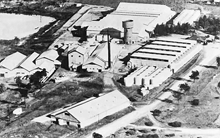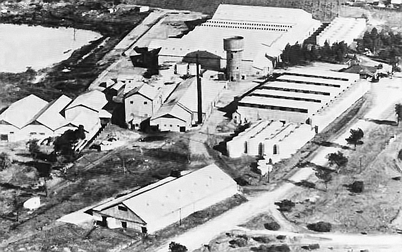|
1932 Vintage Crush 13,622 Tons
Friday April 1st 1932
Grape prices for South Australia
River Murray Irrigation Districts l
| |
Variety |
Baume |
|
| |
Winemaking |
|
|
| |
Doradillo |
12 |
£4/15/- |
| |
Gordo
Blanco |
14 |
£6/10/- |
| |
Gordo
Blanco Distillation |
14 |
£5/10/- |
| |
Grenache |
15 |
£7/-/- |
| |
Hermitage,
White |
14 |
£6/-/- |
| |
Mataro |
14 |
£6/-/- |
| |
Malaga |
14 |
£6/5/- |
| |
Muscatel |
14 |
£6/-/- |
| |
Pedro
Ximenes |
13 |
£6/10/- |
| |
Shiraz |
15 |
£8/5/- |
| |
Sultana |
14 |
£8/10/- |
| |
Zante
Currant |
14 |
£8/10/- |
| |
Dried
Grapes-below standard |
|
£14/-/- |
| |
Buck Currants |
|
£14/-/- |
| |
Dried
Doradillo Grapes prior 1932 |
|
£18/-/- |
Thursday July 23rd 1932
Oscar Seppelt. He thought that Berri had accomplished in 10 years what the Industry had needed 80 years to achieve. B. Seppelt & Sons Ltd had purchased up to £100,000 worth of spirit a year from Berri. Bill Rump started at Seppeltsfield as a mail boy, but such was his efficiency that he was soon promoted to more important positions, and he had amply justified the trust him.
Thursday December 1st 1932
Mr. J. C. Cheriton, the Chairman tells the story how in two years the distillery has gained seven prizes in open competition.
Today there are 540 shareholders and wages paid out during the busy season amount to £500 each fortnight. The distillery has cost up to date, £181,000, and shareholders reserve and capital total £63,000.
Six hundred tons of fruit have been handled in a working day.
The total tonnage handled in 1932 was 13,000 tons of fruit. In 1931, 15,500 tons and in 1930, 19400 tons.
About £6,000 in wages is paid out each 12 months, and 40 men find employment here. During the season 70 men are employed.
Mr. Rump has been known to taste 200 bottles in one day. As Mr. Cheriton said "If I want to know good wine from bad I watch Rump's face as he "twists" a taste round in his mouth".
1933 Vintage Crush
Thursday March 9th 1933
This report was presented to shareholders on the 6th of March Annual General Meeting. Since May last year the company had dispatched the following amounts of fortified sweet wine:-
| Export
of Fortified Sweet Wine, May 1932-March 1933 |
| Month |
Gallons |
| May-1932 |
70,000 |
| June |
85,000 |
| July |
36,000 |
| Transfer
of London Stocks |
123,000 |
| December |
30,000 |
| Jan-1933 |
114 |
| February |
70,000 |
| March |
22,000 |
From the various reports of stocks of wine, sales of wine internally and export, fortifying and brandy stocks, the industry was in delicate position. The Chairman assured the meeting that the Company was not insolvent and will be able to pay fixed prices on 1929, 1931 and 1932 vintages. There was still a problem with large stocks of spirit in our Bond. 31,000 gallons have been sold and possibilities exist to quit 308,000 gallons. It appeared the storage space would be a problem if the sales did not take place soon. The Doradillo intake would have to be extended. I comment that it was hard times and the shareholders rang the changes.
The new board met on Wednesday 7th March and elected Mr. W. N. Ellis, Chairman, and Mr. W. H. Lister vice-chairman.
Thursday May 4th 1933
Mr. Frank. E. Wilson of Clare, was appointed to the position of assistant winemaker to assist the Manager Mr. Bill Rump with increasing production of fortified wine.
Lately there had been rumours that the Company was price cutting in London, but in spite of this, despatches of large volumes overseas were being made.
The large Doradillo tonnages were becoming a problem and a way was needed to make an acceptable sweet fortified wine suitable for export using this variety. The grape is very neutral in flavour and even at 12° Baume and upwards, was low in acid and often had a coarse palate. Quotas had been in force for some weeks and open delivery days were receiving up to 400 tons a day, and given the fine weather, the grapes were of excellent quality.
In September Mr. W. A. Rump was stood down and Mr. W. S. Garnett was appointed General Manager.
Thursday October 1933
A third payment on the 1929 vintage resulting in a total distribution in the order of £19,700 was made and there were further prospects of a further payment at the end of the year.
Entries in the annual Royal Adelaide Wine Show were awarded Highly Recommended marks in the classes for ruby or dark port, tawny port, sweet white and Muscat wines. |







